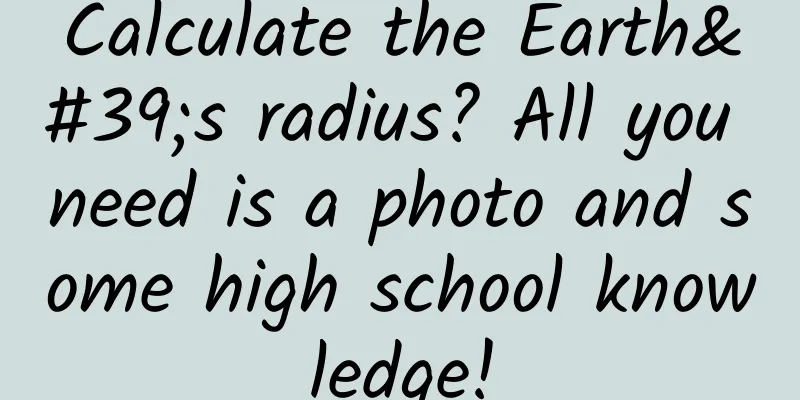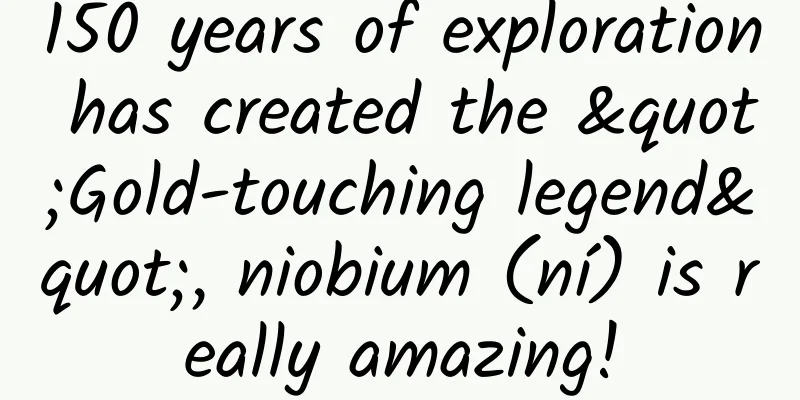Calculate the Earth's radius? All you need is a photo and some high school knowledge!

|
Based on a photograph of the sunset over a lake, Professor Robert J. Vanderbei of Princeton University proved that the earth is round and gave the radius of the earth. Written by Ji Yang (Institute of Semiconductors, Chinese Academy of Sciences) and Gao Guoqiang (Harbin Institute of Technology (Weihai)) Knowing that something can be made is the biggest clue. As long as you know that something can be made, even if you don't know how it is made, many people can make it. In the history of scientific development, such things are not uncommon. For example, Galileo invented the telescope. In fact, Galileo was not the first person to invent the telescope. In May 1609, Galileo accidentally heard that someone in the Netherlands had invented a "magic mirror" that could see distant scenery. Instead of visiting or buying this "magic mirror", he made two instruments by himself in less than three months and used them to look up at the starry sky. He observed the shadows cast by the highlands and craters on the moon, discovered sunspots, and discovered the four largest satellites of Jupiter. With the help of the telescope, Galileo also discovered the rings of Saturn, the rotation of the sun, the waxing and waning of Venus and Mercury, the diurnal and monthly libration of the moon, and that the Milky Way is composed of countless stars, etc. The following example happened in modern times. On July 5, 2008, Professor Robert J. Vanderbei of Princeton University took a photo of the sunset by Lake Michigan. The sun was about to fall below the horizon, leaving a reflection on the lake. Professor Vanderbei realized that by using this photo, plus some high school physics and mathematics knowledge, he could prove that the earth is round and get the radius of the earth. Figure 1 Sunset over Lake Michigan in the United States. Photographed by Professor Vanderbei of Princeton University on July 5, 2008. 01 Basics The physical knowledge required here is: light propagates in a straight line; when light is reflected by a mirror, the angle of incidence is equal to the angle of reflection. The mathematical knowledge required here is: the Pythagorean theorem, the sum of the squares of the two right-angled sides is equal to the square of the hypotenuse; the sine theorem of a triangle, that is, the length of the side of a triangle is proportional to the sine of the opposite angle. The key point is this: the water surface is flat like a mirror and can reflect sunlight. However, the "flatness" of a mirror or water surface is only local flatness, and the surface of the earth is curved. If you and I stand in two different places, your "flatness" will be "slanted" for me. For parallel incident sunlight, the inclination angle of the water surface in different places relative to the sunlight is different. This analysis is straightforward, but somewhat tedious. Below we write out the analysis in detail so that readers of "Mathematics, Physics and Chemistry for Middle School Students (Junior High School Edition)" can also understand it. We suggest that readers try to derive it on their own first, and then come back to our explanation if they encounter difficulties. We also derived it on our own when we only knew the conclusion. The difficulty of this problem is not in the derivation, but in realizing that this picture contains all the information needed for the conclusion . 02 Model and derivation The schematic diagram of our analysis (Figure 2) is similar to that of Professor van der Bei, but with some new symbols for detailed explanation, and the analysis process is slightly different. The specific instructions are as follows: 03 Data analysis Professor Van der Bei conducted a data analysis of the photo (Figure 3): The diameter of the sun is 317 pixels, and the height of the sun above the horizon is Figure 3 Professor van der Bei’s data analysis of the sunset over the lake. The radius of the Earth can be obtained as But this is a bit too precise, isn't it necessary for such a simple model? 04 discuss In short, the Earth is huge, and to know if it is round, or even to measure its radius, you need to travel a long way. However, Professor Vanderbei of Princeton University realized that by taking a photo of sunrise or sunset at the seaside (or a large lake), you can prove that the earth is round and get the radius of the earth. And the principle here is very simple, even middle school students can understand it. The difficulty lies in that you must first realize that you can get all this information based on this photo. In hindsight, this analysis is simple, but the first person to realize the truth is still remarkable. The key is that he thought about it seriously. Maybe someone else has thought about it before, or even written about it. Important things will always be discovered many times. On the one hand, there is nothing new under the sun; on the other hand, new concepts, new methods and new measuring instruments bring new insights, and deep thinking about the "natural" phenomena we see every day can sometimes yield rewards. People should have realized that the earth is round a long time ago, but they were always a little off. For example, in the Spring and Autumn Period and the Warring States Period, we know: "When Confucius climbed the Eastern Hill, he looked down on Lu; when he climbed Mount Tai, he looked down on the world" (Mencius: The Doctrine of the Mean); "I have tried to stand on tiptoe to look, but it is not as good as the broad view from a high place" (Xunzi: Encouragement to Study). Now it seems obvious that the latter is obvious: climbing high gives you a broad view because the horizon recedes. Of course, this is only a qualitative understanding, and Mencius and Xunzi did not infer that the earth is round. There are also quantitative data. In the chapter "On the Sun" in Lun Heng, Wang Chong of the Eastern Han Dynasty said: "Let a person walk on a flat and unobstructed road at night with a big torch. The torch will go out after ten miles away." On a plain, if a person walks at night with a torch, you will not be able to see the torch after he walks about ten miles away. Here, there is a quantitative data of "ten miles", and the height of the torch from the ground is about one or two meters. From this, it can be inferred that the diameter of the earth is about tens of thousands of miles. Unfortunately, Wang Chong did not realize this, but used this as evidence of the "Gaitian Theory" to refute the "Huantian Theory" (which now seems more reasonable to us). Of course, people have long guessed that the earth is round, such as Shen Zi and Zhang Heng in ancient China, and Pythagoras and Aristotle in ancient Greece. It is said that in the 3rd century BC, the ancient Greek astronomer Eratosthenes first calculated the circumference of the earth based on the sunlight shining on the earth at noon and the distance between two observation sites. In 726 AD, the Tang Dynasty astronomer Yixing presided over the national astronomical and geodetic survey, and calculated the length of one degree of the meridian and the circumference of the earth using the altitude of the North Pole and the length of the summer day. This article may also answer a common question: Why can't textbooks be written in more detail? The answer is that they can be written in more detail, but the book will become too thick. There are still many factors and details that have not been considered in the analysis of the sunset by the lake. Please think about how they will affect the results of the analysis. For example, if you take such photos in different parts of the world on the same day, the results will be different; even if you take such photos in the same place on different days, the results will be different. This is because the earth revolves around the sun (on the ecliptic plane), and the earth's rotation axis is not perpendicular to the ecliptic plane. Therefore, if you take photos in the same place for many days, or take photos in many places on the same day, you can get a lot of information, including but not limited to: the earth is round, the radius of the earth, the central angle of the rotation axis relative to the ecliptic plane, the latitude of the place where the photo was taken, etc. Of course, you may also realize that this is similar to a sundial. You can also get this information by sticking a pole to observe the sun's shadow, observing the same place for a year, or recording many places on the same day. Ancient people didn't have cameras, but they also observed and thought. 05 A limerick This book is divided into: I was walking by the lake in the evening when suddenly an idea came to me. There is a sun in the sky, and its image is reflected on the water surface. From this we can know that the earth is a sphere. Using geometry knowledge, we can get the radius of the earth. References [1] Robert J. Vanderbei, The earth is not flat: An analysis of a sunset photo, Optics & Photonics News (OPN), 34-39, November 2008. [2] https://vanderbei.princeton.edu/FRS_131/lectures/lec3.pdf This article is supported by the Science Popularization China Starry Sky Project Produced by: China Association for Science and Technology Department of Science Popularization Producer: China Science and Technology Press Co., Ltd., Beijing Zhongke Xinghe Culture Media Co., Ltd. |
>>: Another sighting? Is it the truth or the Loch Ness Monster?
Recommend
Magical contrast: Why can some people not open bottle caps but split watermelons with their bare hands?
In the eyes of many people, the strength of girls...
Apple disables ChatGPT to prevent confidentiality leaks! A large-scale version of Siri will be upgraded and launched soon
This article is reprinted with permission from AI...
Have cockroaches in Guangdong "evolved"? This speculation is unscientific!
According to Guangdong Radio and Television Stati...
Found in the deep sea, but originating from space, this is the rare element plutonium
By detecting plutonium-244, the heavy metal struc...
2019 Li Zhe Trigger Point Therapy Video
Course Catalog 2019 Li Zhe Trigger Point Therapy ...
What is the strength of "Dongfeng Express" that can deliver 12,000 kilometers in just 20 minutes?
On September 25, 2024, the Chinese People's L...
Zhihu account anti-ban rules and product promotion guidelines!
1. My experience of selling products on Zhihu, fr...
How to sell virtual products and public account SEO on WeChat, earn 10,000 yuan a month part-time at home
Two years ago, knowledge payment became popular, ...
Introduction to 360 mobile resource advertising promotion display formats!
Mobile resources: six advertising formats to meet...
Many iOS encryption measures are not actually used, study finds
According to Johns Hopkins University cryptograph...
20 rules for short video ads to go viral!
Brand advertisers want to achieve results, and pe...
Rules for Creating Popular Online Course Products
In July this year, the "double reduction&quo...
How to make your fans happy to accept your advertisement
I believe many of you have had this experience: y...
From Objective-C to Swift: Some Thoughts and Opinions
In this post I want to talk to you about my recen...









